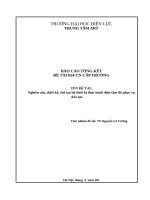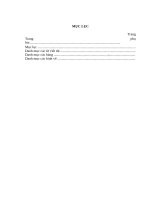ĐIỆN tử VIỄN THÔNG D8DTVT2 nhom8 bai4 khotailieu
Bạn đang xem bản rút gọn của tài liệu. Xem và tải ngay bản đầy đủ của tài liệu tại đây (32.16 KB, 3 trang )
Họ và tên : Vũ Anh Cường
Trần Văn Tuất
Lê Văn Hải
Đỗ Mạnh Cường
Nguyễn Văn Đại
Phạm Hồng Phái
MAKING A RECORDING
1 . Vocabulary
Engineer: kỹ sư
Mix: trộn, pha
Commercial : buôn bán
Musicians: nhạc sĩ
Product: Sản phẩm
Stereo: bản in đúc
Instrument : dụng cụ
Tape : băng ghi âm
Process: trải qua
Effects : kết quả.
Vocalist: ca sĩ
Plugged: làm giả
Sequence: chuỗi
Feed: vật liệu cung cấp cho máy
Task 1:
1:D
4: B
2: A
5: F
3: E
6: C
Task 3:
Each instrument is recorded using a microphone. The sound are fed to a mixing
desk. The recording level are controlled and the EQ is adjusted by the sound engineer.
The output is recorded on a multitrack. The sounds from the multitrack are mastered
back through the mixer. The tape is remixed until the musicians are happy with the
sound. Special effects can be added on the mixing desk. The remixed tape is mastered
down to produce a master tape. This can be used to produce copies in many different
formats.
Task 5 :
Place
Studio
People
Equipment
Sound engineer
Microphone
Vocalist
Master tape
Mixer
Multiltrack recorder
Musician
Task 6:
Fistly, a blank perspex disc is grinded and poslished to optical flatness. Next, it is
washed and spin-dried. It is then coated with a thin layer of photoresist and cured in an
oven. After that, as the disc is revolved, a laser beam is used to mark audio information
pattern on its surface. This process is known as ‘cutting’ disc. The photoresist is then
developed and etched to produce pits in the disc’s surface. These pits represent the
digital audio pattern. The disc is then given a thin silver coat to make it electrically
conductive. Next, the electroplanting is used to make a series of positive and negative
copies of the master disc. The final negative copy is used to make a large number of
indentical CDs. The surface of CD containing the pits marks is then coated with a 10
mm layer of aluminium, followed by a protective layer of plastic. Afterpunching the
centre hole,a label is applied and the CD is packaged.









